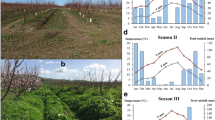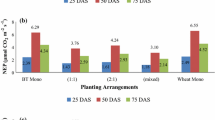Abstract
We compared symbiotic N2 fixation by winter forage legumes (clovers, medics and vetches) using the 15N natural abundance technique in three experiments. Vetches (Vicia spp.) were the most productive legumes, and woollypod vetch fixed (shoot+root) up to 265 kg N ha−1 (mean 227 kg N ha−1) during a 4–5 months period over winter and early spring. Balansa and Berseem clovers, and Gama medic were highly productive in the first experiment, but fixed significantly less N than woollypod vetch in the second experiment. A 6-year study (1997–2003) compared cotton (Gossypium hirsutum L.) systems with and without vetch, or with faba beans (Vicia faba L.) to assess the effects of these crops on cotton production. Woollypod vetch was grown either between annual cotton crops, or between wheat (Triticum aestivumL.) and cotton crops. Vetch added 230 kg N ha−1 (174 kg fixed N ha−1) to the soil when incorporated as a green manure. Faba bean shoot residues and nodulated roots contributed 108 kg fixed N ha−1 to the soil, following the removal of 80 kg N ha−1 in the harvested seed (meaned over three crops). Lablab (Lablab purpureus L. – summer-growing and irrigated) added 277 kg N ha−1 (244 kg fixed N ha−1) before incorporation as a green manure in the first year of the experiment. The economic optimum N fertiliser rate for each cropping system was determined every second year when all systems were sown to cotton. Cotton following cotton required 105 kg fertiliser N ha−1, but only 40 kg N ha−1 when vetch was grown between each cotton crop. Cotton following wheat required 83 kg fertiliser N ha−1 but no N fertiliser was needed when vetch was grown after wheat (the highest yielding system). Cotton following faba beans also required no N fertiliser. The vetch-based systems became more N fertile over the course of the experiment and produced greater lint yields than the comparative non-legume systems, and required less N fertiliser. While no cash flow was derived from growing vetch, economic benefits accrued from enhanced cotton yields, reduced N fertiliser requirements and improved soil fertility. These findings help explain the rotational benefits of vetches observed in other regions of the world.
Similar content being viewed by others
References
P J Bauer J J Camberto S H Roach (1993) ArticleTitleCotton yield and fiber quality response to green manures and nitrogen Agron. J. 85 1019–1023 Occurrence Handle1:CAS:528:DyaK2cXisVensrk%3D
Boquet D J, Breitenbeck G A, Coco A B 1994 Cover crops and nitrogen rate to optimise irrigated cotton yields with conservation tillage. In: Proc. Beltwide Cotton Conf. San Diego, CA, USA. pp. 1513–1515. National Cotton Council, Memphis, USA
Boquet D J, Hutchinson R L, Brown R E A, Thomas W J 1997 Cotton yield and growth on clay soil under different levels of tillage, nitrogen and cover crop. In: Proc. Beltwide Cotton Conf. New Orleans, LA, USA. Vol. 1, pp. 636–638. National Cotton Council, Memphis, USA
D J Boquet R L Hutchinson K W Paxton (2003) ArticleTitleConservation tillage, cover crop BMP’s for cotton La. Agric. 46 32–33
L O Brandsaeter A Olsmo A M Tronsmo H Fyske (2002) ArticleTitleFreezing resistance of winter annual and biennial legumes at different development stages Crop Sci. 42 437–443
Breitenbeck G A, Hutchinson R L, Boquet D J 1994 Nitrogen status of cotton following winter cover crops. In: Proc. Beltwide Cotton Conf. San Diego, CA, USA. pp. 1505–1507. National Cotton Council, Memphis, USA
Y S Cho (2003) ArticleTitleNitrogen fixation and growth characteristics of␣three legume cover crops in no-tillage paddy field Korean J. Crop Sci. 48 305–15
G R Cline A F Silvernail (2002) ArticleTitleEffects of cover crops, nitrogen and tillage on sweet corn Horttechnology 12 118–125
G A Constable I J Rochester (1988) ArticleTitleNitrogen application to cotton on clay soil: timing and soil testing Agron. J. 80 498–502
G A Constable I J Rochester Daniells (1992) ArticleTitleCotton yield and nitrogen requirement is modified by crop rotation and tillage method Soil Tillage Res. 23 41–59
A M Decker A J Clark J J Meisinger F R Mulford M S McIntosh (1994) ArticleTitleLegume cover crop contributions to no-tillage corn production Agron. J. 86 126–135
J Evans A M McNeill M J Unkovich N A Fettell D P Heenan (2001) ArticleTitleNet nitrogen balances for cool-season grain legume crops and contributions to wheat nitrogen uptake: a review Aust. J. Exp. Agric. 41 347–359 Occurrence Handle1:CAS:528:DC%2BD3MXkt1Crtr0%3D
J Evans G Scott D Lemerle A Kaiser B Orchard G M Murray E L Armstrong (2003) ArticleTitleImpact of legume ‘break’ crops on the yield and grain quality of wheat and its relationship with soil mineral N and crop N content Aust. J. Agric. Res. 54 777–788
S J Guldan C A Martin (2003) ArticleTitleHairy vetch biomass yield as affected by fall planting date in the irrigated steppe of the southern Rocky Mountains J. Sust. Agric. 22 17–23
R J Haynes M H Beare (1997) ArticleTitleInfluence of six crop species on aggregate stability and some labile organic fractions Soil Biol. Biochem. 29 1647–1653 Occurrence Handle1:CAS:528:DyaK1cXhs12rtQ%3D%3D
A B Hearn (1986) ArticleTitleEffect of preceding crop on the nitrogen requirements of irrigated cotton (Gossypium hirsutum L.) on a vertisol Field Crops Res. 13 159–175
S A Hossain S A Waring W M Strong R C Dalal E J Weston (1995) ArticleTitleEstimates of nitrogen fixation by legumes in alternate cropping systems at Warra, Queensland using enriched−15N dilution and natural 15N abundance techniques Aust. J. Agric. Res. 46 493–505
M M Hussein M A Ashoub H A El-Zeiny (1985) ArticleTitleCotton growth and yield as affected by irrigation and nitrogen fertiliser Ann. Agric. Sci. 30 975–991
E S Jensen (1987) ArticleTitleSeasonal patterns of growth and nitrogen fixation in field-grown pea Plant Soil. 101 29–37
ZhuQun Jin GuangDi Cao FeiBo Wu LuPing Xu MinJie Wang Z Q Jin G D Cao F B Wu L P Xu M J Wang (1997) ArticleTitleThe effects of application of different amounts of nitrogen fertiliser on the yield of short-season cotton Zhejiang Nongye Kexue 6 275–277
D F Khan M B Peoples P M Chalk D F Herridge (2002) ArticleTitleQuantifying below-ground nitrogen of legumes 2. A comparison of 15N and non isotopic methods Plant Soil 239 277–289 Occurrence Handle10.1023/A:1015066323050 Occurrence Handle1:CAS:528:DC%2BD38XktFWitrw%3D
S Kilian P Berswoldt-Wallrabe Particlevon H Steele D Werner (2001) ArticleTitleCultivar specific dinitrogen fixation in Vicia faba studied with the nitrogen-15 natural abundance method Biol. Fert. Soil 33 358–364 Occurrence Handle1:CAS:528:DC%2BD3MXjtlGnsbs%3D
K Kumar K M Goh (2000) ArticleTitleCrop residues and management practices: effects on soil quality, soil nitrogen dynamics, crop yield and nitrogen recovery Adv. Agron. 68 197–319 Occurrence Handle1:CAS:528:DC%2BD3cXivVehurg%3D
F Kurdali N E Sharabi A Arslan (1996) ArticleTitleRainfed vetch–barley mixed cropping in the Syrian semi-arid conditions. 1. Nitrogen nutrition using 15N isotopic dilution Plant Soil 183 137–148 Occurrence Handle1:CAS:528:DyaK28Xnt1arsbc%3D
J A Larson R K Roberts E C Jaenicke D D Tyler (2001) ArticleTitleProfit-maximising nitrogen fertilization rates for alternative tillage and winter cover crops J. Cotton Sci. 5 156–168
M A Latif G R Mehuys A F MacKenzie I Alli M A Faris (1992) ArticleTitleEffects of legumes on soil physical quality in a maize crop Plant Soil 140 15–23 Occurrence Handle1:CAS:528:DyaK38XitFemt7o%3D
McConnell J S, Baker W H, Frizzell B S 1995 Cotton yield response to five irrigation methods and ten nitrogen fertilization rates. Special Report – Agricultural Experiment Station, Division of Agriculture, University of Arkansas. No. 172: pp. 157–162
A M McNeill C Zhu I R P Fillery (1997) ArticleTitleUse of in situ 15N-labelling to estimate the total below-ground nitrogen of pasture legumes in intact soil-plant systems Aust. J. Agric. Res. 48 295–304
K A McVay D E Radcliffe W L Hargrove (1989) ArticleTitleWinter legume effects on soil properties and nitrogen fertiliser requirement Soil Sci. Soc. Am. J. 53 1856–1862
E P Millhollon (2002) ArticleTitleAfter 40 years, winter crops still produce superior cotton yields La. Agric. 45 5–6
Millhollon EP, Braud AD 1999 Effects of winter cover crops on cotton yield and soil fertility after 40 years. In: Proc. Beltwide Cotton Conf. Orlando, Florida, USA. Vol. 1, pp. 33–34. National Cotton Council, Memphis, USA
T Mueller K Thorup-Kristensen (2001) ArticleTitleN-fixation of selected green manure plants in an organic crop rotation Biol. Agric. Hortic. 18 345–363
I Papastylianou (1988) The role of legumes in agricultural production in Cyprus D P Beck L A Materon (Eds) Nitrogen Fixation by Legumes in Mediterranean Agriculture Martinus Nijhoff Dordrecht 55–64
R W Payne (1987) Genstat 5 reference manual Clarendon Press Oxford
M B Peoples J A Baldock (2001) ArticleTitleNitrogen dynamics of pastures: nitrogen fixation inputs, the impact of legumes on soil nitrogen fertility, and the contributions of fixed N to Australian farming systems Aust. J. Exp. Agric. 41 327–346 Occurrence Handle1:CAS:528:DC%2BD3MXkt1Crtrw%3D
M B Peoples R M Boddey D F Herridge (2002) Quantification of nitrogen fixation G J Leigh (Eds) Nitrogen Fixation at the Millennium Elsevier Science Amsterdam 357–389
M B Peoples A M Bowman R R Gault D F Herridge M H McCallum K M McCormick R M Norton I J Rochester G J Scammell G D Schwenke (2001) ArticleTitleFactors regulating the contributions of fixed nitrogen by pasture and crop legumes to different farming systems of eastern Australia Plant Soil 228 29–41 Occurrence Handle1:CAS:528:DC%2BD3MXhtlWkur8%3D
M B Peoples R R Gault B Lean J D Sykes J Brockwell (1995) ArticleTitleNitrogen fixation by soybean in commercial, irrigated crops of central and southern New South Wales Soil Biol. Biochem. 27 553–561 Occurrence Handle1:CAS:528:DyaK2MXlt12rtr8%3D
M Rangappa A A Hammam H L Bhardwaj (2002) ArticleTitleLegume and grass cover crops for seedless watermelon production Horttechnology 12 245–249
I J Rochester M B Peoples G A Constable (2001a) ArticleTitleEstimation of the N fertiliser requirement of cotton grown after legume crops Field Crops Res. 70 43–53
I J Rochester M B Peoples G A Constable R R Gault (1998) ArticleTitleFaba beans and other legumes add nitrogen to irrigated cotton cropping systems Aust. J. Exp. Agric. 38 253–260
I J Rochester M B Peoples N R Hulugalle R R Gault G A Constable (2001b) ArticleTitleUsing legumes to enhance nitrogen fertility and improve soil condition in cotton cropping systems Field Crops Res. 70 27–41
G D Schwenke M B Peoples G L Turner D F Herridge (1998) ArticleTitleDoes nitrogen fixation of commercial, dryland chickpea and faba bean crops in north-west New South Wales maintain or enhance soil nitrogen? Aust. J. Exp. Agric. 38 61–70
InstitutionalAuthorNameSoil Survey Staff (1996) Keys to Soil Taxonomy, Seventh edition Natural Resources Conservation Service of USDA Washington, DC 644
S D Sparrow V L Cochran E Sparrow (1995) ArticleTitleDinitrogen fixation by seven legume crops in Alaska Agron J. 87 34–41
SPSS 2000 SigmaPlot 2000 for Windows. Version 6.00
M J Unkovich J S Pate P Sanford (1997) ArticleTitleNitrogen fixation by annual legumes in Australian Mediterranean agriculture Aust. J. Agric. Res. 48 267–293
M J Unkovich J S Pate P Sanford E L Armstrong (1994) ArticleTitlePotential precision of the δ15N natural abundance method in field estimates of nitrogen fixation by crop and pasture legumes in south-west Australia Aust. J. Agric. Res. 45 119–132
J J Varco S R Spurlock O R Sanabria-Garro (1999) ArticleTitleProfitability and nitrogen rate optimization associated with winter cover management in no-tillage cotton J. Prod. Agric. 12 91–95
J D Vaughan G D Hoyt A G Wollum (2000) ArticleTitleCover crop nitrogen availability to conventional and no till corn: soil mineral nitrogen, corn nitrogen status and corn yield Comm. Soil Sci. Plant Anal. 31 1017–1041 Occurrence Handle1:CAS:528:DC%2BD3cXjtVKkurY%3D
S K Yau M Bounejmate J Ryan R Baalbaki A Nassar R Maacaroun (2003) ArticleTitleBarley-legume rotations for semi-arid areas of Lebanon Eur. J. Agron. 19 599–610
Author information
Authors and Affiliations
Corresponding author
Rights and permissions
About this article
Cite this article
Rochester, I., Peoples, M. Growing vetches (Vicia villosa Roth) in irrigated cotton systems: inputs of fixed N, N fertiliser savings and cotton productivity. Plant Soil 271, 251–264 (2005). https://doi.org/10.1007/s11104-004-2621-1
Received:
Accepted:
Issue Date:
DOI: https://doi.org/10.1007/s11104-004-2621-1




